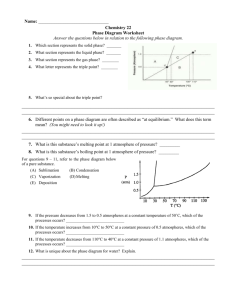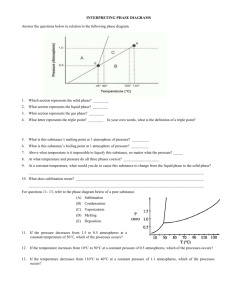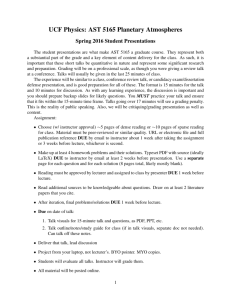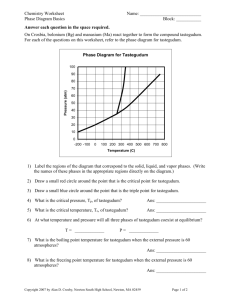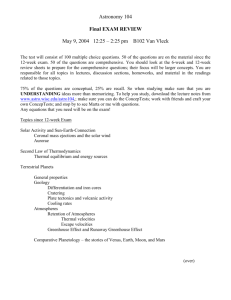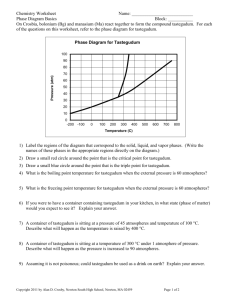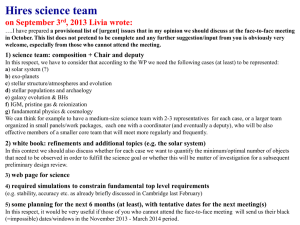3-ATMOSPHERES
advertisement
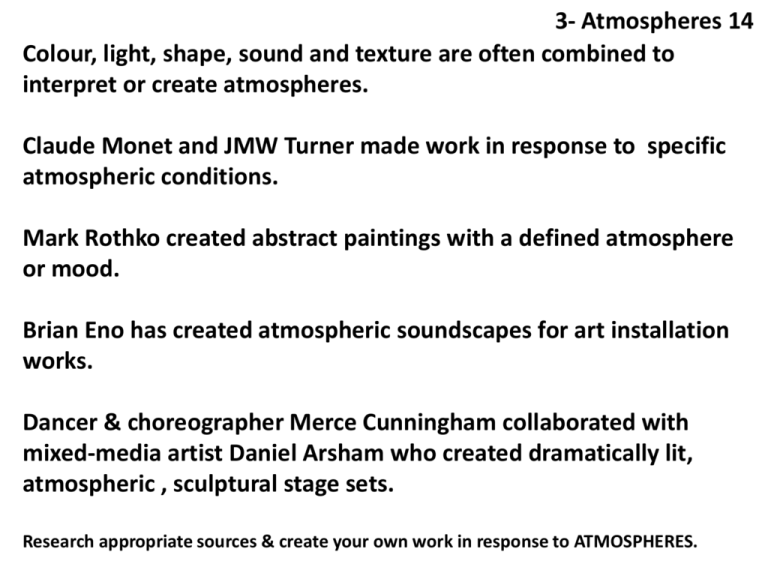
3- Atmospheres 14 Colour, light, shape, sound and texture are often combined to interpret or create atmospheres. Claude Monet and JMW Turner made work in response to specific atmospheric conditions. Mark Rothko created abstract paintings with a defined atmosphere or mood. Brian Eno has created atmospheric soundscapes for art installation works. Dancer & choreographer Merce Cunningham collaborated with mixed-media artist Daniel Arsham who created dramatically lit, atmospheric , sculptural stage sets. Research appropriate sources & create your own work in response to ATMOSPHERES. Joseph Turner, “Rain Wind Speed” Claude Monet and JMW Turner made work in response to specific atmospheric conditions. 3- Atmospheres 14 Joseph Turner, “Hannibal and his Army Crossing the Alps” 3- Atmospheres 14 Claude Monet and JMW Turner made work in response to specific atmospheric conditions. For Turner, the figure of Hannibal – here leading his armies to attack Italy – had powerful associations with Napoleon. These connections had been explicitly drawn in an official portrait of Napoleon about to lead his own armies across the St Bernard Pass. Snow Storm, however, does not celebrate the power of the individual, but expresses man’s vulnerability in the face of nature’s overwhelming force. Hannibal himself is not pictured, and attention is focused upon victims of the conflict, the struggling soldiers. Joseph Turner, various studies of Venice 3- Atmospheres 14 Claude Monet and JMW Turner made work in response to specific atmospheric conditions. Joseph Turner, “Incident at the London Parliament” 1834 3- Atmospheres 14 Claude Monet, “Houses of Parliament” 1904 Claude Monet and JMW Turner made work in response to specific atmospheric conditions. Claude Monet, “Rouen Cathedral” 3- Atmospheres 14 Claude Monet and JMW Turner made work in response to specific atmospheric conditions. Claude Monet, “Series of Haystack studies” 3- Atmospheres 14 Claude Monet and JMW Turner made work in response to specific atmospheric conditions. 3- Atmospheres 14 Joseph Turner, “Venice Grand Canal With Santa Maria Della Salute” 1820 Claude Monet, “The Grand Canal in Venice” 1908 Claude Monet and JMW Turner made work in response to specific atmospheric conditions. Monet… brushstrokes up close 3- Atmospheres 14 Claude Monet and JMW Turner made work in response to specific atmospheric conditions. Mark Rothko “Chapel” Mark Rothko created abstract paintings with a defined atmosphere or mood. 3- Atmospheres 14 Mark Rothko “TATE GALLERY” 3- Atmospheres 14 Mark Rothko created abstract paintings with a defined atmosphere or mood. Brian Eno 3- Atmospheres 14 Brian Eno has created atmospheric soundscapes for art installation works. Brian Eno Brian Eno has created atmospheric soundscapes for art installation works. 3- Atmospheres 14 Brian Eno Brian Eno has created atmospheric soundscapes for art installation works. 3- Atmospheres 14 Merce Cunningham Dancer & choreographer Merce Cunningham collaborated with mixedmedia artist Daniel Arsham who created dramatically lit, atmospheric , sculptural stage sets. 3- Atmospheres 14 Daniel Arsham Dancer & choreographer Merce Cunningham collaborated with mixedmedia artist Daniel Arsham who created dramatically lit, atmospheric , sculptural stage sets. "Study for Occupant", by Daniel Arsham x Jonah Boaker, live performance for the opening of "Reach Ruin", the Fabric Workshop and Museum, PA, December 14th 2012 3- Atmospheres 14 Daniel Arsham Installation view of "Pixel Clouds", set design for the last performances of the Merce Cunningham Dance Company,Park Avenue Armory, NY, 2011 "REPLICA", set design and performance, in collaboration with Jonah Bokaer, New Museum, NY, 2009 3- Atmospheres 14 "Avalanche", set design for the Merce Cunningham Dance Company, Adrienne Arsht Center, Miami, FL,2010 "REPLICA", set design and performance, in collaboration with Jonah Bokaer, at IVAM, Valencia, Spain, 2009 Daniel Arsham 3- Atmospheres 14 No matter how warped the objects of Daniel Arsham’s work may appear, there is always a sense that behind the ostensible obsession with disorder is a curious fascination with the possibilities of the environment around us. Through his own practice and with the architectural collaboration Snarkitecture, he explores and negotiates the relationship between nature and the built environment, and in his most recent exhibitions – ‘STORM’ at Galerie Perrotin in Paris and ‘Reach Ruin’ at the Fabric Workshop & Museum Philadelphia – Arsham revisits the memories of a hurricane that ravaged his childhood home 20 years ago. Erosion and entropy seem to be central themes in a lot of your work? So much of my work has always been about the manipulation and reformulation of architecture. I never traced this back to the experience of this storm until a few years ago, when it came up in an interview. But I certainly think I was always interested in architecture and how it might be made to do things that it wasn’t supposed to do. I always felt that architecture is meant to and often does have this very solid quality. It creates spaces that we inhabit for safety and comfort, and my work was always about disrupting that – but doing so in a very subtle way, which creates a distinctly uncanny quality. Can you please tell us more about Snarkitecture? Where did the idea originally come from? Snarkitecture came out of an experience I had when I was working on a project in a public space in Los Angeles. Much of my work up to that point had often manipulated architecture, making it melt and ripple and drip and fold, but it was always in a scenario where I didn’t have to meet building code. For this project, I engaged my friend Alex Mustonen – he was studying architecture at Cooper Union when I was at the art school – to help me both retain the intention of the work and also make it feasible in relation to building codes and permanence. Following that there seemed to be a lot of opportunities in this grey area that functioned somewhere between artistic practice and more rigid architectural practice, so we formed Snarkitecture in 2007. The name comes from a Lewis Carroll poem called ‘The Hunting of the Snark’, in which a group of misfits are on an ocean searching for a beast called the Snark. They don’t know what the beast looks like or where it is, they’re just searching for a kind of a formless entity. We felt that Snarkitecture is sort of doing the same thing. - See more at: http://www.designmiami.com/designlog/columns-listing/design-links/daniel-arsham-ala-champfest-magazine/#sthash.bcpE5I7R.dpuf David Oxtoby, “Portrait of John Lennon” 3- Atmospheres 14 David Oxtoby, Oxtoby’s Rockers 3- Atmospheres 14 Emma Knowles, “portraits of her children” 3- Atmospheres 14 Sarah Keer-Keer, Ice skaters 3- Atmospheres 14 Sarah Keer-Keer, divers, ganet, port seton http://www.sarahkeerkeer.co.uk/exhib.htm Nicolas Archer, edge of the forest, In the thicket & Toddler 3- Atmospheres 14 Nicolas Archer, Rodeo, Races, Carousel 3- Atmospheres 14 Nicolas Archer, Rodeo, & the forever England series 3- Atmospheres 14 Nicolas Archer, New work 3- Atmospheres 14 http://nicholasarcher.com/NicholasArcher.html Kandinsky 3- Atmospheres 14 Marc Chagall “Paris Through the Window” 1913 3- Atmospheres 14 Francis Bacon Pope Innocent X 1953 Bacon also used a still image from Sergei Eisenstein’s 1925 film Battleship Potemkin in as an influence for his Study after Velazquez’s Portrait of Pope Innocent X (right) 3- Atmospheres 14 Francis Bacon Pope Innocent X 1953 3- Atmospheres 14
